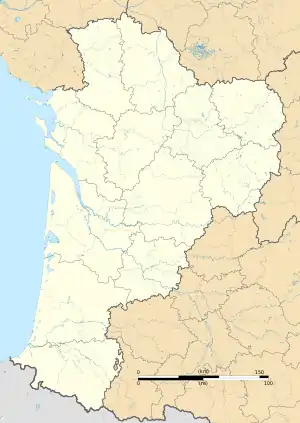Lescar | |
|---|---|
 Cathedral | |
 Coat of arms | |
Location of Lescar | |
 Lescar  Lescar | |
| Coordinates: 43°20′01″N 0°26′05″W / 43.3336°N 0.4347°W | |
| Country | France |
| Region | Nouvelle-Aquitaine |
| Department | Pyrénées-Atlantiques |
| Arrondissement | Pau |
| Canton | Lescar, Gave et Terres du Pont-Long |
| Intercommunality | CA Pau Béarn Pyrénées |
| Government | |
| • Mayor (2020–2026) | Valérie Revel[1] |
| Area 1 | 27 km2 (10 sq mi) |
| Population | 9,524 |
| • Density | 350/km2 (910/sq mi) |
| Time zone | UTC+01:00 (CET) |
| • Summer (DST) | UTC+02:00 (CEST) |
| INSEE/Postal code | 64335 /64230 |
| Elevation | 142–203 m (466–666 ft) (avg. 154 m or 505 ft) |
| 1 French Land Register data, which excludes lakes, ponds, glaciers > 1 km2 (0.386 sq mi or 247 acres) and river estuaries. | |
Lescar (French pronunciation: [lɛskaʁ] ⓘ; Occitan: Lescar) is a commune in the Pyrénées-Atlantiques department and Nouvelle-Aquitaine region of south-western France.[3]
Lescar is the site of the Roman city known variously as Benearnum, Beneharnum or Civitas Benarnensium, the location providing the name for the later region of Béarn.[4]
In 841, Benearnum was razed by the Vikings and Morlaàs became the Béarnaise capital. However, from the twelfth century a new city grew up at Lescar. Lescar Cathedral was built during this period, and was the seat of the Diocese of Lescar until 1801.[5] The remains of the last monarchs of all Navarre Queen Catherine I (†1517) and King John III (†1516) lie at the cathedral.
Today, Lescar is primarily a suburb of the nearby town of Pau. The commune of Lescar has joined together with 30 neighbouring communes to establish the Communauté d'agglomération Pau Béarn Pyrénées which provides a framework within which local tasks are carried out together.
Population
|
| ||||||||||||||||||||||||||||||||||||||||||||||||||||||||||||||||||||||||||||||||||||||||||||||||||||||||||||||||||
| Source: EHESS[6] and INSEE (1968-2017)[7] | |||||||||||||||||||||||||||||||||||||||||||||||||||||||||||||||||||||||||||||||||||||||||||||||||||||||||||||||||||
Twin towns
 L'Alfàs del Pi, Spain
L'Alfàs del Pi, Spain
See also
References
- ↑ "Répertoire national des élus: les maires" (in French). data.gouv.fr, Plateforme ouverte des données publiques françaises. 13 September 2022.
- ↑ "Populations légales 2021". The National Institute of Statistics and Economic Studies. 28 December 2023.
- ↑ INSEE commune file
- ↑ "Alphabetical Catalogue of Sites and Peoples of Roman Gaul - Benearnum = Beneharnum / Civ. Benarnensium". University of South Carolina. Retrieved 2008-06-28.
- ↑ French Atlantic Coast. Michelin Apa Publications Ltd. October 2007. p. 338. ISBN 978-1-906261-17-7.
- ↑ Des villages de Cassini aux communes d'aujourd'hui: Commune data sheet Lescar, EHESS (in French).
- ↑ Population en historique depuis 1968, INSEE